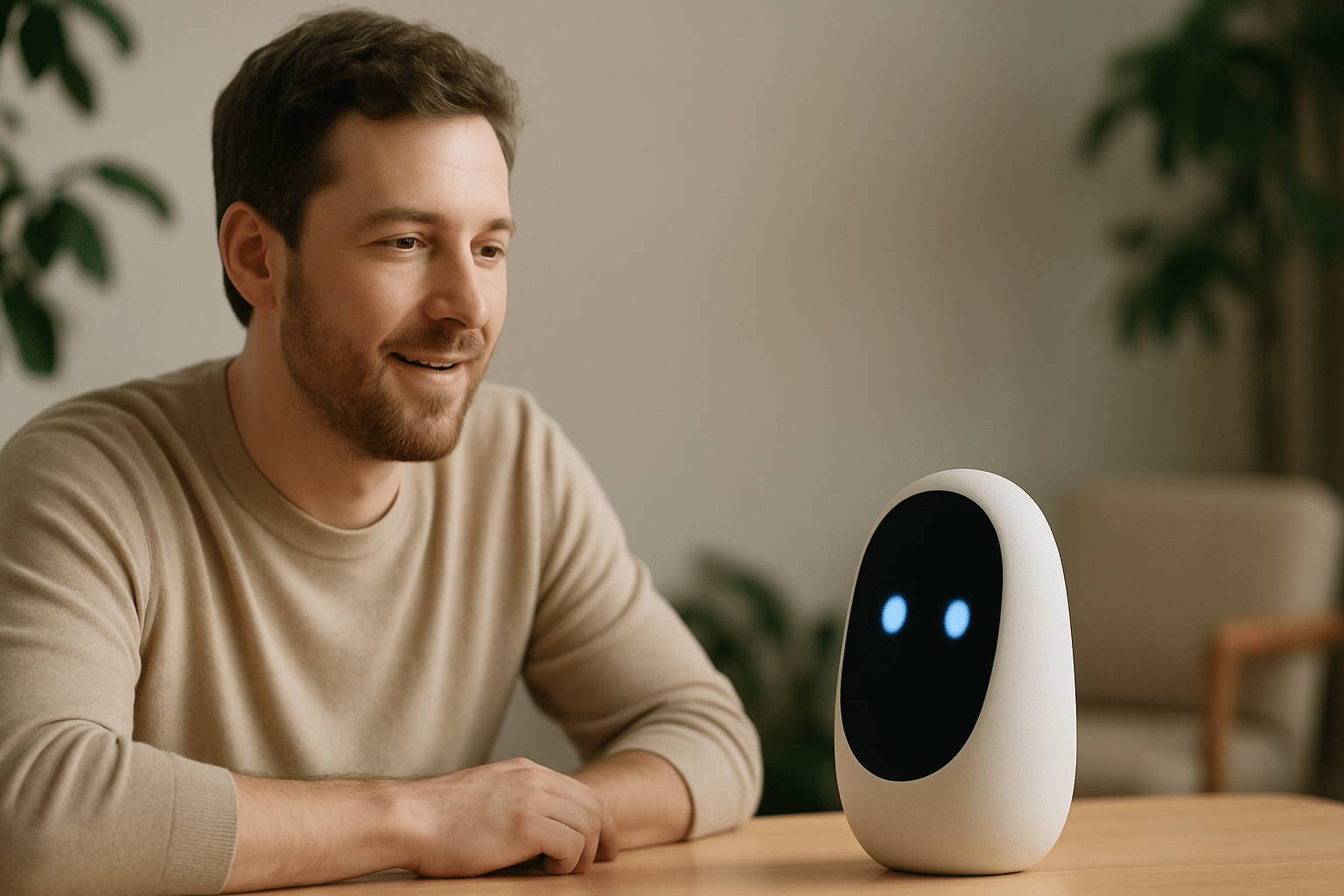We stand at the threshold of a fundamental shift in how humans interact with technology. OpenAI’s $6.5 billion acquisition of Jony Ive’s hardware startup io signals more than just another tech deal. It represents a philosophical statement about AI’s future physical embodiment.
For the past three decades, screens have dominated our relationship with technology. They’ve mediated our interactions, captured our attention, and increasingly created barriers between human connections.
This screenless AI companion concept directly challenges our current attention economy. It proposes technology that gets out of the way rather than demanding our focus.
Reimagining Human-Technology Relationships
The vision for this device isn’t just about removing screens. It’s about fundamentally altering how technology integrates into our daily lives.
“Technology in the last 10 years has almost, while it has aided human-to-human connection, in some ways supplanted it,” as we’ve witnessed rising isolation and loneliness.
We believe the shift toward screenless technology will allow us to incorporate AI in a more comprehensive way. Technology can finally get out of the way and genuinely support daily life.
This creates freedom of location and positioning. No longer tethered to screens, our interactions can become more natural and contextual.
The social signals that currently interrupt human conversations when someone looks at a screen will transform. Screenless AI can join those conversations without creating the same distractions.
Jony Ive’s Human-Centered Design Philosophy
The most functional design is design that gets out of the way. It allows you to accomplish goals without hitting frustrations and roadblocks.
Jony Ive’s design philosophy, which transformed Apple products over the past decades, has consistently prioritized human experience over technological showcasing.
This approach aligns perfectly with OpenAI’s vision. The partnership aims to create technology that integrates seamlessly into our lives while helping us focus on human-to-human connection.
Both Altman and Ive have expressed concerns about screen addiction, with Ive revealing he “shoulders a lot of the responsibility for what these things have brought us” regarding the iPhone’s impact on users’ attention and anxiety. This drives their vision to create technology that blends into the background rather than demanding attention. Source
We’ve seen how Apple products became extensions of ourselves rather than just tools. This same philosophy applied to AI could transform our relationship with technology again.
Environmental Awareness and Contextual Computing
An environmentally aware AI device introduces fascinating possibilities for contextual computing. It’s like adding another player into a scenario.
We’ve already welcomed Siri, Alexa, and Google Assistant into our homes. These devices are always listening, and we’ve each established our own comfort levels with that reality.
The screenless companion takes this further. As it becomes more environmentally aware of our physical spaces, we’ll likely interact with AI more casually.
It becomes more useful because we won’t need to explain ourselves repeatedly. Similar to conversations with good friends, there’s a comfort level where pretense falls away.
Privacy concerns remain significant. Having all that power concentrated in a single company like OpenAI poses potential challenges to data democracy.
The device will be compact but not wearable, designed to perceive surroundings through cameras and microphones for environmental awareness. It will offload complex computing tasks to connected devices while maintaining privacy. Source
Challenging the Google Monolith
Google has dominated the device, search, and advertising space for decades. They’ve essentially powered the entire internet ecosystem.
We see this OpenAI-Ive partnership as a fundamental shift away from Google being the only titan in the arena.
Previous attempts to challenge Google’s search dominance have largely failed. Microsoft’s Bing struggled to capture significant market share until recent AI integrations.
The widespread adoption of ChatGPT opens the door to truly compete with Google. If OpenAI can prioritize privacy in its monetization model, it could present a compelling alternative.
Google’s business model relies on offering free products in exchange for access to user data. A different approach that respects privacy could disrupt this established pattern.
Trust: Earned in Drops, Lost in Bucket Fills
The challenges in helping users adapt to screenless interaction will be significant. We’ve seen similar hurdles with voice assistants like Google Assistant, Alexa, and Siri.
Success ultimately depends on usability. Can these devices actually accomplish what we want them to accomplish?
User agency remains crucial. We want AI to shop for us, but we need to trust it’s making decisions aligned with our preferences.
Building relational trust and consistency over time becomes the key factor. Human-in-the-loop checkpoints where we can edit AI decisions will be essential.
Trust in technology mirrors trust in relationships. It’s earned slowly but can be lost instantly. The Apple Maps launch demonstrates this principle perfectly.
When Apple Maps initially launched, it led many users astray. Personal experiences of getting lost created lasting trust issues with the platform.
OpenAI’s device will need to nail the experience from day one. First impressions will significantly impact adoption.
Democratizing AI: 100 Million Units by 2026
The ambitious goal of shipping 100 million units by 2026 indicates OpenAI’s confidence in widespread adoption. This isn’t just about elite tech users.
ChatGPT’s adoption rate far surpassed other technology markers over the last decade. We’re witnessing increasing openness to rapid tech adoption.
Security and privacy concerns remain the primary barriers. If OpenAI can address these effectively while seamlessly integrating their solution into daily life, rapid acceptance seems likely.
OpenAI has set this ambitious goal with Altman claiming they’ll accomplish this “faster than any company has ever shipped 100 million of something new before,” signaling extraordinary confidence despite the revolutionary nature of the device. Source
The timeline suggests OpenAI believes we’re at an inflection point in AI adoption. We’re seeing massive integration of AI across platforms, devices, tools, and SaaS offerings.
Restoring Human Connection
If we can position technology as a helpful silent companion that reduces distractions and interruptions, we believe it will allow us to engage with people on a more human level.
Removing screens from our faces creates space for deeper connections. It potentially addresses the screen addiction issues many people face today.
We’ve grown accustomed to seeing wearable technology like AirPods and Apple Watches. Initially distracting, they’ve become normalized in social settings.
This screenless AI companion could follow a similar adoption pattern while avoiding the “uncanny valley” effect of devices like Apple Vision Pro.
By allowing us to talk to our AI device and have it handle tasks in the background, we maintain focus on human interactions.
The Future of Business in a Screenless World
Businesses will need to adapt by creating integrated marketing experiences and building their own interactive AI agents as representatives.
Each person will have their own AI persona that interacts with other AI agents to find solutions and services.
Human service industries will remain essential. Home services, legal representation, and similar fields won’t disappear.
Information-based businesses face greater disruption. Blog writers and content creators may struggle as AI handles information gathering and distribution.
The next generation of entrepreneurs will build companies specializing in AI representation. They’ll create AI agents that effectively embody brand values and offerings.
Legal implications loom large. Companies are already held liable for website content. How will this extend to AI representatives? Can businesses audit everything their AI says about them?
AI Safe Spaces and New Social Norms
We anticipate the development of AI-free zones. These will be spaces where recording is prohibited, similar to how some venues ban photography.
Consent to being recorded will become a more complex issue. States with different recording consent laws will need to adapt to AI companions.
AI devices may need to announce their presence, particularly when recording. Privacy modes will become essential features.
Organizations will likely update their data policies to address AI recording and training. Intellectual property considerations will shape these policies.
Visual indicators, like the recording light on Meta’s glasses, will likely become standard. These signals will help establish new social norms around AI companions.
The Linguistic Shift
Our language is already changing. “Googling” something is giving way to “I talked to ChatGPT about that.”
We expect phrases like “I was asking AI” or “I was talking to AI about this” to become commonplace.
This linguistic shift reflects a deeper change in how we conceptualize technology. AI becomes less of a tool and more of a collaborator.
The way we refer to technology reveals our relationship with it. This evolution signals AI’s integration into our social fabric.
Beyond the Screen
We stand at the beginning of a profound transformation in human-technology interaction. OpenAI’s partnership with Jony Ive represents more than a business move.
It signals a philosophical shift away from the attention economy that has dominated digital life.
By creating technology that gets out of the way, this vision promises to restore human connection while maintaining technological advancement.
The true measure of success won’t be technical specifications or sales figures. It will be whether these devices genuinely enhance human experience and connection.
That’s the promise of the human-centered AI revolution. Not just better technology, but technology that better serves humanity.



